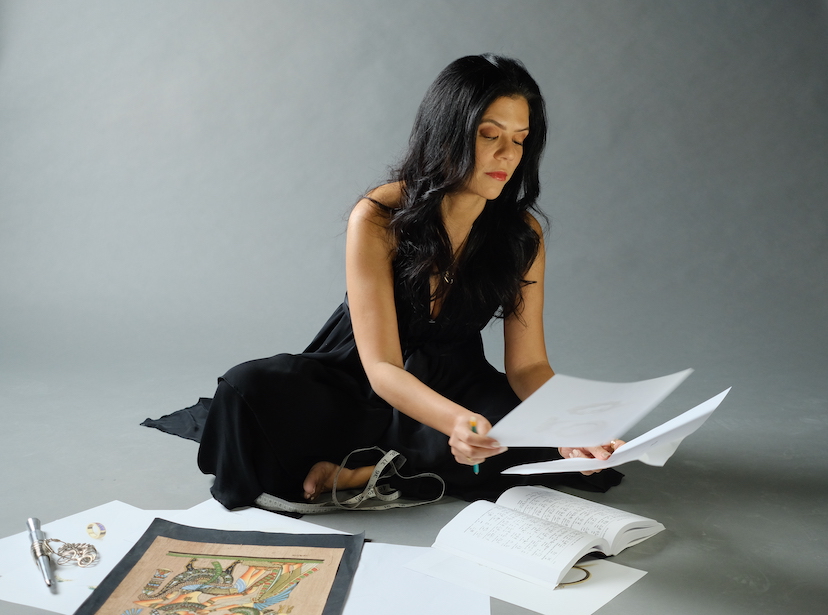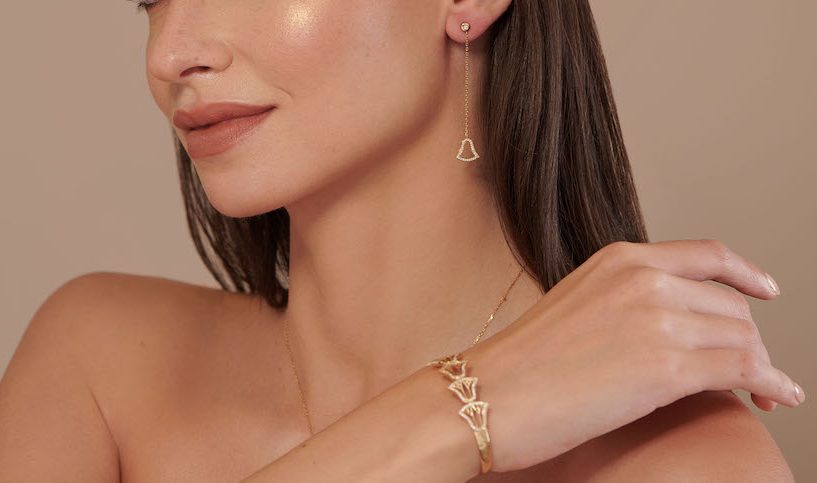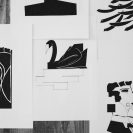Ancient Egyptian mythology has fascinated the minds of designers for decades. I mean, how could one forget Karl Lagerfeld’s last Métiers d’Art show for Chanel? A regal celebration of scarabs and pyramid-shaped bags paraded down the runway, it was a fanfare of bold gold alongside pristine Lapis blue. Ancient Egyptian jewelry is forever iconic, for it represents a way of life and a culture that continues to captivate the young minds of today’s world. For jewelry designer Rasha Mansour, her aim is to honor and preserve the authentic meaning and message behind these Ancient Egyptian relics to present a jewelry line that is modernly inimitable, yet also tells a story.
Based in Dubai, jewelry designer Mansour believes that “Egyptomania” is taking over the world, and her jewelry label is not only a product of passion but also a well-studied art form. She begins by telling bazaar, “I have studied The Egyptian Mysteries for the last 12 years with a teacher called Katy Noura Butler, who lives in Nazlet El Semman by the Giza Pyramids. Every piece I do is thoroughly thought-out, and I follow the exact dimensions of what the Ancient Egyptians used to create their art.” Pyramids, for instance, are scaled-down using exact measures, and precise attention to detail shows exacting textures seen on Ancient Egyptian tombs and relics.

Mansour’s jewelry presents an artistic journey in its own right, one that captivates the viewer from the very moment they’ve laid eyes on one of her pieces. Already an Egyptian-celebrity fan favorite, her pieces have made crowd-pleasing appearances on none other than Mona Zaki, who wore a stunning selection of the designer’s jewelry at the recent Cairo International Film Festival.
An up-close view of the now dubbed “Mona” Earring left everyone dazzled:
Mansour never claimed to be a traditionally trained jewelry designer, but her passion led her to vigorously self-learn. “I am self-taught over a period of 15 years of reading about jewelry and stones and spending a lot of time with my mother in the old jewelry factories in Deira, Dubai, and meeting the talented artisans there. I remember grasping all the details and mechanisms very clearly and creating pieces from all types of material in my teens. My passion for stones came particularly from years of self-healing negative patterns within myself, which led me to the discovery of crystal healing and the benefits of each stone.” She recounts how she would spend so much time agonizingly taking care of her mother’s jewelry, carefully detangling necklaces, and in doing so she began collecting her own pieces as a young teen.
Her foray into jewelry design began when a family jeweler actually wanted to copy a piece of jewelry she had liked in a shop, but had deemed overpriced. “And then I stopped dead in my tracks. I was in a corporate job for almost 20 years and I realized I had barely designed or done anything creative during that time. I told him I would be back. I went home that day and sketched my first piece based on inspiration from the piece I had seen and the result was 100 percent different from what I wanted to copy. A friend saw it, ordered one, then I started sketching more. Then I went back to my old books on gold and jewelry and stones and dived into it more for a few months and here we are.” Her work is quickly evolving though, further developing her sketches and her obsession with the Lotus flower continues to grow in all of its different representations.
Lotuses feature widely in her pieces, observed for thousands of years by Ancient Egyptian culture as a symbol of the sun, creation, and rebirth, as the flower follows the sun cycle, closing up and sinking beneath the waters of the Nile at night, to rise once again and open up at dawn. Not only is Mansour’s presentation of the lotus ever-so-striking and modern, but it is also true to form, emulating the curves of the beautiful flower. She cites the Ancient Egyptians’ obsession with the afterlife as her muse for the Lotus. “They lived for the afterlife and prepared for it. They knew this life. And I love how they revered the lotus flower for what it stood for. It grows with roots latched in mud. It submerges every night into river water and then just like a miracle re-blooms the next morning sparkling clean. That’s why this flower is associated with rebirth and enlightenment. That’s what we, as humans, all need and what we are going through. You see, If I could recreate my identity through my designs then so can anyone. I left my corporate job which was extremely toxic to me and was actually starting to affect my physical health to pursue a passion that does nothing but give me positive energy and so much love every day. I am sure that a lot of people will relate to my vision of Rebirth especially in regards to what we all went through in the last few years.”
From the stunning detail featured in the Isis Necklace, which portrays the goddess Isis who wept for her beloved husband Osiris, the goddess of love Hathor, the Eye of Horus which feature as a statement pendant or earrings, long known as a symbol of protection, regal power, and good health. Mansour’s designs are so intricate, especially when we consider her recreation of King Tut’s dagger, which was originally first found as part of King Tut’s tomb filled with treasures, to the goddess Bastet. These pieces did require time for their first production, but with good reason too, as the designer explains her process, “Bastet took three months and King Tutankhamen’s dagger took around two months. This is because I study the details, and the history of each original piece and recreate it as best as I can. Recreating the God Ptah, for instance, who was believed to be the God of Craftsmanship in Ancient Egypt, meant that I had to melt the gold over 16 times until I got him right.”
Mansour’s caring eye in her selection of stones is not to be overlooked either, as she incorporates certified gemstones and diamonds to complete a given piece’s telling story. She says, “I visualize the pieces first. I close my eyes and visualize each colored stone and what would work. Then I research stones of that color that co-relate to the meaning of the piece. I produce it and then wear it around for a few days to see how I feel. I have rarely changed the stones and I am grateful that my visualization is strong as is my intuition.” Mansour has also chosen to work with only 18 Karat gold because she wants her clients to invest in jewelry, and not just buy it because it’s nice-looking or pretty. “The resale value is important to me,” she explains, adding that she thoroughly considers the weight of her pieces. “I care a lot about my clients’ ears. Yes, ears. Obsessed actually. I weigh all earrings before mass producing and wear them around the house a lot to ensure my clients won’t need stitches in a few years due to the weight of the earrings.”
We asked the designer about her favorites from her collection, and she cites her Ankh pieces and the Five Flower Lotus bracelet to be close to her heart. She also favors Khepri, the scarab god, and has created so many pieces modeling this icon, including the now-famous Golden Parade ring. Khepri’s chosen symbol, the scarab beetle keeps him connected to the sun. Whether you choose the Khepri rendition with pearl, citrine, or resplendent sapphires reminiscent of the Pharaonic reverence of prized Lapis Lazuli, this ring is definitely a statement maker and will turn heads wherever you go.

You can shop Rasha Mansour’s jewelry easily on her website, and we highly recommend that you take the time to read her posts on the jewelry line’s official Instagram account, @ByRashaMansour, as the designer will regale you with stories about Ancient Egyptian culture. Every buying experience can be easily personalized by reaching out to Mansour via DM, as she takes the time to speak to her customers about the journey of each and every special piece.
We close our conversation with Mansour by asking her about she would like to do next, “Continue to do what I am doing, grow my vision of creating timeless heirlooms that will be passed from mother to daughter or father to son, and continue hearing ‘Rasha, since I put it on I haven’t been able to take it off.’ That’s the most amazing thing to hear.”
Shop By Rasha Mansour on her website www.ByRashaMansour.com and follow her latest work on Instagram @ByRashaMansour.








